|
The
third time is the hardest. Even in a country like India, where the
economy is currently, despite some concerns over the impact of rising
oil and commodity prices, on a roll, it isn't easy to pick companies
to watch, 20 of them, year after year (after year, actually). Which
is what makes this listing, the third of its kind, unique. For the
record, most companies picked by this magazine in 2002 and 2003
have turned out pick-worthy, although there have been some high-profile
(and embarrassing) flame-outs, an equal number of quiet failures,
and a few cases of companies that, while still looking extremely
promising, are neither better off nor worse than they were in 2002
and 2003. Like always, this listing of 20 Companies to Watch in
2005 is a balanced mix of the big and the small, the sexy and the
ordinary and the listed and the unlisted across a range of sectors.
Like always, it was put together by BT's team of reporters and editors
across cities after interviews with executives, consultants, bankers
and venture capitalists and private equity investors. Read it, remember
these companies (at least those of them you have not heard of yet),
and, if you like what you see in the gatefold How
The 20 Companies To Watch In 2003 And 2004 Have Performed (we
think you just might) go ahead and invest in them. We'll watch them
for you.
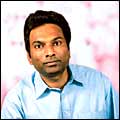 APPLABS APPLABS
Sashi Reddi/Founder & CEO
Test Case
Not too long ago,
when software companies wished to put code-jocks out to pasture
they just moved them to testing. That, IT emerges, is no longer
the case. Testing has become a $3 billion (Rs 13,500 crore) a year
market and both service providers and customers are increasingly
displaying a preference for third-party testing. Thus, if a customer
signs an application development contract with IBM or Infosys, it
is likely to give the task of testing the result to a third party.
Pitching for a chance to be at the vanguard of this trend is a Philadelphia-
and Hyderabad-based company, Applabs Technologies.
"We hope to be the biggest in terms of
size and among the top three in terms of revenues," says Sashi
Reddi, a Wharton alum who founded the company in 1998, adding that
Applabs is the only software testing company in the world assessed
at level 5 of the Capability Maturity Model, a software quality
standard. Venture Capital firm WestBridge Capital Partners thinks
so too; in September this year, it invested $7 million (Rs 31.5
crore) in the company. "This investment will provide us the
financial strength to go out and acquire the talent and the testing
companies we need to become the market leader in the software testing
space," says Reddi, explaining that he hopes to achieve this
distinction in the next two years. For a company that has closed
the first half of this year with an estimated Rs 13 crore in revenues
that will take some doing. Still, Applabs is at the vanguard of
a trend and that counts for something.
-E. Kumar Sharma
BHARTI TELE-VENTURES
Sunil Mittal/CEO
Wireless Wonder
 As
this sentence is being written, India has over 45 million mobile
telephony subscribers. One company, Bharti Tele-Ventures, has over
9 million of these. Only Reliance Infocomm has more subscribers,
but not by much (its telecom play was one reason why it was part
of the first companies to watch list this magazine put out in late
2003), and the business is yet to return net profits. Bharti, for
the record, is profitable: it returned a net profit of Rs 620 crore
on revenues of Rs 5,000 crore in 2003-04, and in the first half
of this year, it has returned a net profit of Rs 630 crore on revenues
of Rs 3,565 crore. With the competitive topography of the telecommunications
market more or less defined, it would be reasonable to expect Bharti
to retain its marketshare. That would mean the company can expect
to have 20 million subscribers in the next two years, and if India
touches the 200 million mobile subscribers mark in the next five
years as Bharti CEO Sunil Mittal expects it to, 40 million subscribers
by 2010. "I see no reason why Airtel (the company's service
brand) should stop growing," says Mittal. As
this sentence is being written, India has over 45 million mobile
telephony subscribers. One company, Bharti Tele-Ventures, has over
9 million of these. Only Reliance Infocomm has more subscribers,
but not by much (its telecom play was one reason why it was part
of the first companies to watch list this magazine put out in late
2003), and the business is yet to return net profits. Bharti, for
the record, is profitable: it returned a net profit of Rs 620 crore
on revenues of Rs 5,000 crore in 2003-04, and in the first half
of this year, it has returned a net profit of Rs 630 crore on revenues
of Rs 3,565 crore. With the competitive topography of the telecommunications
market more or less defined, it would be reasonable to expect Bharti
to retain its marketshare. That would mean the company can expect
to have 20 million subscribers in the next two years, and if India
touches the 200 million mobile subscribers mark in the next five
years as Bharti CEO Sunil Mittal expects it to, 40 million subscribers
by 2010. "I see no reason why Airtel (the company's service
brand) should stop growing," says Mittal.
With everything from network installation and
management to it outsourced to companies that should know these
businesses well (think Ericsson, Nokia, Siemens and IBM), Bharti
can afford to focus its efforts on marketing and service. Better
still, the network-outsourcing model allows the company to grow
its operations with almost no capital expenditure. "The deal
with Ericsson, Nokia and Siemens means that we only pay for air-line
usage and whenever the network starts getting congested, they invest
in additional hardware," says Jai Menon, Corporate Director
and Joint President, Bharti Tele-Ventures. While the competition
is sceptical of the network outsourcing arrangement-a senior exec
at a large mobile telephony company dismisses it as financial window
dressing-analysts such as Rahul Singh, who covers telecommunications
for Mumbai-brokerage SSKI, cannot stop singing its praise. "This
will allow Bharti to scale up very quickly," he says. "And
concentrate on understanding the consumer." Indeed, with its
mind off operational issues, Bharti has been quick to forge an alliance
with rim and launch Blackberry, arguably the world's most successful
email-through-wireless solution, in India, a move that should help
it narrow rival Hutch's lead in the value-added services area. And
Menon has been busy wrestling with technological decisions involving
Wi-Max, a sort of Wi-Fi on steroids. Far more importantly, Bharti's
business model is focussed on minimising operating costs. "On
costs, I think Bharti is unbeatable," says Singh. Which is
why the company is here.
-Kushan Mitra
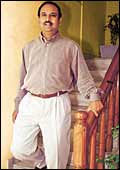 BHARAT
BIOTECH INTERNATIONAL BHARAT
BIOTECH INTERNATIONAL
Krishna M. Ella/Chairman and Managing Director
Biotech Opportunist
Circa 1986, Krishna
E. Ella was a technical officer at Bayer's Indian operations. Today,
he is one of India's foremost biotech entrepreneurs. And in the
18 years separating the two dates, he has been a scholar at the
University of Hawaii, served as a research professor at the Medical
University of South Carolina, completed a PhD from the University
of Wisconsin, Madison, sold all personal assets and relocated to
India at the suggestion of his wife Suchitra, and, along with her,
co-founded Bharat Biotech in Hyderabad. The last was in 1996 and
in the eight years since then, with Krishna in charge of technology
and Suchitra, marketing and communication, Bharat Biotech has grown
into a Rs 31-crore, multi-product biotech company. Since 1998, the
company, which hopes to touch Rs 500 crore in revenues by 2008,
has launched two vaccines (its best-known is Rev-AC-B, a recombinant
vaccine for Hepatitis B), a probiotic yeast, and a recombinant streptokinase
used in the treatment of myocardial infraction. On the anvil is
Regen-D, a recombinant epidermal growth factor (think: the answer
to burns). Products, however, can only take the company so far;
most biotech analysts see Bharat Biotech's future in contract research
and manufacturing. Krishna is aware of this: the company has been
involved in the manufacture of Hibtiter (Haemophilus Influenzae
b Conjugate Vaccine, and it prevents a kind of meningitis) for Wyeth
Lederle, the first instance of the vaccine being made outside the
us and is manufacturing Recombinant Human Lactoferrin for American
firm Agennix Ltd. That's a start.
-E. Kumar Sharma
BHEL
A.K. Puri/Chairman and Managing Director
Power Play
 We
cannot smile easily," says A.K. Puri, chairman and managing
Director of Bharat Heavy Electricals Limited (BHEL), explaining
away his inability to smile for the camera. "We are in a serious
business." Serious it is, and booming to boot: Puri has orders
in hand for some Rs 30,000 crore, all of which have to be completed
by March 31, 2007. "This is our highest order-book (position)
ever," gushes Puri. The reason? A boom in the power sector
with 80 per cent of the capacity addition (in terms of power generation)
envisaged in the Tenth Five Year Plan (2002-07), work in progress,
as compared to a corresponding proportion of 50 per cent for the
Ninth Five Year Plan. And with BHEL's equipment powering 64 per
cent of India's total installed capacity of 1,12,058 mw and the
government proposing an addition of 1,00,000 mw in the eleventh
and twelfth plans, the public sector company that bags between seven
and eight out of every 10 projects it bids for, and which is increasingly
stretching its reach to Africa and West Asia looks to be on firm
ground. Fears over the erosion of margins loom large, especially
with the entry of Chinese firms such as Dongfang Electric (it outbid
BHEL recently in two projects), and Kaustav Mukherjee, Principal,
at Kearney warns that this, "can cause a slippage in margins".
Still, Puri is confident that a company that has been competing
with the likes of GE, Siemens, Mitsubishi and Hitachi will prevail. We
cannot smile easily," says A.K. Puri, chairman and managing
Director of Bharat Heavy Electricals Limited (BHEL), explaining
away his inability to smile for the camera. "We are in a serious
business." Serious it is, and booming to boot: Puri has orders
in hand for some Rs 30,000 crore, all of which have to be completed
by March 31, 2007. "This is our highest order-book (position)
ever," gushes Puri. The reason? A boom in the power sector
with 80 per cent of the capacity addition (in terms of power generation)
envisaged in the Tenth Five Year Plan (2002-07), work in progress,
as compared to a corresponding proportion of 50 per cent for the
Ninth Five Year Plan. And with BHEL's equipment powering 64 per
cent of India's total installed capacity of 1,12,058 mw and the
government proposing an addition of 1,00,000 mw in the eleventh
and twelfth plans, the public sector company that bags between seven
and eight out of every 10 projects it bids for, and which is increasingly
stretching its reach to Africa and West Asia looks to be on firm
ground. Fears over the erosion of margins loom large, especially
with the entry of Chinese firms such as Dongfang Electric (it outbid
BHEL recently in two projects), and Kaustav Mukherjee, Principal,
at Kearney warns that this, "can cause a slippage in margins".
Still, Puri is confident that a company that has been competing
with the likes of GE, Siemens, Mitsubishi and Hitachi will prevail.
-Sahad P.V.
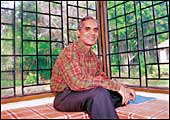 COGNIZANT
TECHNOLOGY SOLUTIONS COGNIZANT
TECHNOLOGY SOLUTIONS
Lakshmi Narayanan/President & CEO
The India Story
No company exemplifies
the great Indian out-shoring story as much as us-and-India-based-Cognizant.
Beginning life as a JV between Satyam Computer and Dun & Bradstreet
in 1994, Cognizant emerged in its present form in the US in 1998,
and promptly went public (CTSH on NASDAQ, and the stock currently
trades at $36.64, Rs 1,649), becoming the first us company with
a strong India focus; others such as IBM, Accenture, even EDs did
not look at India seriously till much later. Then, that was only
to be expected of a company that was founded to leverage the India-opportunity.
The front-end in the us, back-end in India model (one that even
the India-based it heavyweights are trying to move to) seems to
be working: over each of the past eight quarters, Cognizant has
grown revenues by 50 per cent. For the record, it hopes to close
this year (December 31, 2004) with revenues of $581 million (Rs
2,614.5 crore), an estimated net profit of over $85 million (Rs
382.5 crore), and a headcount of 15,000. The growth, says R. Chandrasekaran,
MD and head of Indian operations, stems from "a conscious decision
to maintain operating margins in the 19-20 per cent range and reinvest
everything else in the business", something that the man claims
has helped "strengthen relationships and excellence in execution,
resulting in faster growth and deep differentiation". That
may explain Cognizant's low operating margins (Infosys' is 28.4
per cent, TCS' 27.3 per cent, and Wipro's 21 per cent). It could
also explain the 10-20 per cent premium (in terms of Price-Earnings
multiple) its stock boasts over Infosys' on NASDAQ although that
could change after the latter's second ads listing (see story Infosys
Inc.). There are areas of concern. "Cognizant's challenge
is to become a leader through differentiation, rather than being
a follower in commodity-based categories of service," says
Frances Karamouzis, Research Director, Gartner, a technology consultancy.
Still, the company is sanguine about its chances of crossing the
$1-billion-in-revenues-mark in the next six to eight quarters. For
a latecomer to India's it party, that's something.
-Nitya Varadarajan
ECLERX
Priyadarshan Mundhra/Co-founder
The New New Job
 Forget
the name with plebeian associations for a moment. eClerx is a business
process outsourcing (BPO) firm, a minnow (it expects to end 2004
with $6 million, Rs 27 crore in revenues) in an industry dominated
by some really big firms. Only, its business model doesn't revolve
around transferring a process to India. "We devise processes
that did not even exist for our clients," says Priyadarshan
Mundhra, a Citibank (India) alum who teamed up with Wharton classmate
Anjan Mallik (a former Lehman Brothers employee) to found eClerx
in late 2000-the year probably explains the name. "So, it is
not just a question of shifting jobs offshore, but about creating
altogether new jobs." These new jobs have to do with high-end
analytics, from risk management systems for derivatives trading
to price benchmarking services for retailers. eClerx currently serves
seven clients, including some Wall Street biggies, and expects to
grow by 60-80 per cent over the next three years. "The aggregate
revenues of our existing customers is in excess of $200 billion
(Rs 9 lakh crore)," says Mallik. "Assuming even a 15 per
cent operating expenditure, which is low, you are talking about
$30 billion (Rs 1,35,000 crore) of spend of which an increasing
proportion will be to players like us. Add to that, the additional
fillip of the overall migration of work to India and we should anticipate
growth well in excess of the market." Barring some concerns
over that old bugbear, scalability, eClerx does look like the new
new thing. Forget
the name with plebeian associations for a moment. eClerx is a business
process outsourcing (BPO) firm, a minnow (it expects to end 2004
with $6 million, Rs 27 crore in revenues) in an industry dominated
by some really big firms. Only, its business model doesn't revolve
around transferring a process to India. "We devise processes
that did not even exist for our clients," says Priyadarshan
Mundhra, a Citibank (India) alum who teamed up with Wharton classmate
Anjan Mallik (a former Lehman Brothers employee) to found eClerx
in late 2000-the year probably explains the name. "So, it is
not just a question of shifting jobs offshore, but about creating
altogether new jobs." These new jobs have to do with high-end
analytics, from risk management systems for derivatives trading
to price benchmarking services for retailers. eClerx currently serves
seven clients, including some Wall Street biggies, and expects to
grow by 60-80 per cent over the next three years. "The aggregate
revenues of our existing customers is in excess of $200 billion
(Rs 9 lakh crore)," says Mallik. "Assuming even a 15 per
cent operating expenditure, which is low, you are talking about
$30 billion (Rs 1,35,000 crore) of spend of which an increasing
proportion will be to players like us. Add to that, the additional
fillip of the overall migration of work to India and we should anticipate
growth well in excess of the market." Barring some concerns
over that old bugbear, scalability, eClerx does look like the new
new thing.
-Priya Srinivasan
 GOKALDAS
EXPORTS GOKALDAS
EXPORTS
Dinesh Hinduja/Executive Director
A quota of success
Bangalore's largest
employer is neither of the city's tech glimmer twins Infosys and
Wipro. That distinction goes to a low-profile garment exporter that
employs 32,000 across the 42 factories it runs in the city.
With the quota regime (effectively something
that put a ceiling on the volume of exports from a particular country)
in apparel set to expire on January 1, 2005, this company, Gokaldas
Exports, is poised on the brink of a great opportunity. It supplies
everything from jackets and parkas to night dresses and underwear
to customers such as gap, Old Navy, Nike, Adidas, Reebok, Fruit
of the Loom, Tommy Hilfiger, Abercrombie and Fitch, Mexx, Polo and
Puma. "We have been around ever since quotas came into play
in 1976," smiles Dinesh Hinduja, Executive Director, Gokaldas
Exports. "With an open regime, we hope to grow faster and have
been making substantial capital investments in anticipation."
In 2003-04, Gokaldas Exports registered revenues
of $140 million (Rs 630 crore) making it the country's largest garment
exporter; it hopes to grow by a modest 20 per cent this year although
it could, according to Hinduja, have very well grown at 30. "
We want to make sure that our systems and process are robust enough
to handle such growth." This, at a time when prices in the
international apparel market have been in a free fall in anticipation
of the end of quotas, a trend that Hinduja expects to see off in
the next 12 months. Next step: factories in Sri Lanka and Bangladesh
that compete with India as centres of the international apparel
trade; and an emphasis on value-added offerings such as outerwear
(think jackets with tape-seamed waterproofing). The Chinese do not
worry Hinduja. What does, is a demand supply imbalance in bias of
the former that he fears will set off a mad rush by the opportunistic
to enter the business, and end with (following their inability to
meet international standards of quality and delivery) an erosion
of India's brand equity. And what does is the Indian labour regime
that makes it difficult for companies to up or reduce workforce
and poor infrastructure.
-Venkatesha Babu
HICAL MAGNETICS
Sashikiran Mullur/Managing Director
The Litmus
 Its
business is un-sexy, esoteric even; its revenues have remained stagnant
at around Rs 76 crore for the past two years; a planned base in
Shanghai remains just that, a plan; at a time when several Indian
companies are eyeing global markets, this one-time export oriented
unit (EOU) is suddenly focussing on the domestic market with a vengeance
(and suffering at the hands of Chinese competitors). So, just why
is Hical on this list? Simple, the company's fate could be indicative
of that of the Indian manufacturing sector, at least that part of
it that is under threat from the Chinese. Its
business is un-sexy, esoteric even; its revenues have remained stagnant
at around Rs 76 crore for the past two years; a planned base in
Shanghai remains just that, a plan; at a time when several Indian
companies are eyeing global markets, this one-time export oriented
unit (EOU) is suddenly focussing on the domestic market with a vengeance
(and suffering at the hands of Chinese competitors). So, just why
is Hical on this list? Simple, the company's fate could be indicative
of that of the Indian manufacturing sector, at least that part of
it that is under threat from the Chinese.
Bangalore-based Hical makes magnetic components
that go into everything, mobile phones, base stations, telecom rectifiers,
inverters and ups devices, medical equipment, even seat belt control
systems in cars. Not too many companies have the expertise required
to succeed in this market and until recently, Hical was on velvet,
catering to customers such as Nokia, Siemens, Thomson, Ericsson
and GE Medical Systems. Then, over the past 18 months, several customers
moved their manufacturing operations to China; factors related to
logistics and local market knowledge (even proximity) gave Hical's
Chinese rivals an edge. Hical considered investing in a facility
in China, then chose to go down another route. "We had to decide
whether to spread our sparse investable resources too thin or do
something else," says Sashikiran Mullur, Managing Director,
Hical.
The something else turns out to be engineering
design. The ability to design innovative products, says Mullur,
allows the company supply 25-30 parts to customers, as opposed to
two or three earlier. And the booming telecommunications market
in India has attracted at least three companies that are investing
in mobile handset manufacturing facilities in the country, allowing
Hical an opportunity to pay the Chinese back in kind. "While
our focus will be on leveraging our long-standing relationships
with marquee customers, the domestic market has become very bullish
and we want to be both in the high volume and high value game,"
says Mullur. Everyone's watching.
-Venkatesha Babu
 HUGHES
SOFTWARE SYSTEMS HUGHES
SOFTWARE SYSTEMS
Arun Kumar/Managing Director
Software Inside
It may be Hughes'
acquisition of Bangalore-based Tenet Technologies and of the GSM
support business of Lucent Technologies in Germany that helped turn
around the company's fortunes as Arun Kumar, its Managing Director
claims, but in a year that saw the ownership of the company change
twice-Rupert Murdoch's News Corporation acquired it in December
2003 when it bought Hughes Network System and later sold it to Singapore-based
Flextronics in June 2004-it is the fact that it is now part of Flextronics
(the company owns 70 per cent of Hughes following an open offer)
that makes it a shoo-in for this listing.
Flextronics (Revenues of $14.5 billion or Rs
66,700 crore in 2003 and an anticipated $17.4 billion or Rs 78,300
crore in 2004) is the world's largest electronics manufacturing
services (EMS) company. Shorn of jargon, that means the company
manufactures and ships hardware for almost every hardware brand
in the world. Hardware manufacturing is a low-margin business-Ever
wonder why the pc you bought two months ago costs almost 20 per
cent less now?-and companies such as Flextronics survive by reaping
the benefits of scale. The Hughes acquisition, however, should help
the company offer not just hardware but the software embedded in
this (as any analyst will vouch, the quantity of software in hardware
has been steadily increasing) thereby increasing profit margins;
software, after all, is where the money is. "We will be the
software engine for Flextronics worldwide," says Kumar. "The
(Flextronics) deal will get larger and better clients for Hughes,"
adds Gurunath Mudlapur, Head (Research), Khandwala Securities, a
Mumbai brokerage. There!
-Supriya Shrinate
ICICI BANK
K.V. Kamath/Managing Director
Universal Marketer
 We
cannot do an ICICI Bank; it can roll out a retail branch in five
days." That was what the CEO of a new bank told this magazine
recently as he was preparing to open for business. This magazine
found out it took the company slightly longer-30 days from the time
it decides to put down a branch to the time the said branch opens
its doors; see Up In Five Days, Business Today, December 7, 2003-but
the aggression the quote implies is very much part of ICICI Bank's
DNA. From retail banking to home and car loans, to credit cards,
the company is among the market leaders in virtually every possible
business related to banking, and speed is a common thread that runs
through everything. "Eighteen months back we had no international
presence worth speaking of," says Kalpana Morparia, Deputy
Managing Director, ICICI Bank, contrasting that with its present
reach, nine countries across five continents. We
cannot do an ICICI Bank; it can roll out a retail branch in five
days." That was what the CEO of a new bank told this magazine
recently as he was preparing to open for business. This magazine
found out it took the company slightly longer-30 days from the time
it decides to put down a branch to the time the said branch opens
its doors; see Up In Five Days, Business Today, December 7, 2003-but
the aggression the quote implies is very much part of ICICI Bank's
DNA. From retail banking to home and car loans, to credit cards,
the company is among the market leaders in virtually every possible
business related to banking, and speed is a common thread that runs
through everything. "Eighteen months back we had no international
presence worth speaking of," says Kalpana Morparia, Deputy
Managing Director, ICICI Bank, contrasting that with its present
reach, nine countries across five continents.
Its financial institution (FI) provenance-ICICI
reverse merged with ICICI Bank in March 2002-has meant the bank
has a traditional advantage in corporate banking. Now, says Vikram
Sengupta, a banking analyst with Mumbai brokerage Khandwala Securities,
"with the impending credit boom and huge capital expenditure
plans of companies, ICICI Bank has an edge". Non-performing
assets, which seemed a matter of concern at the time of the merger
(they stood at 4.8 per cent of net advances, as compared to under
a per cent for rivals such as HDFC Bank), are now down to 2.6 per
cent, but the FI heritage has saddled the company with a higher
average cost of borrowings (4.4 per cent) than it would like. That,
though, should change and knowing ICICI Bank's track record, very
soon.
-Abir Pal
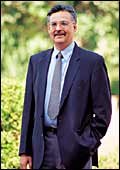 ITC ITC
Yogi Deveshwar/Chairman and Managing Director
Village Voice
The last mile...
in these jargon-ridden times, these three words mean different things
to different people. To the top brass at ITC, the Kolkata-headquartered
tobacco-to-FMCG-to-hotels-and-lots-more giant, they mean opportunity,
growth and profit, not necessarily in that order. There is no organised
marketing and distribution in 87 per cent of India's villages, home
to 50 per cent of the rural population. Low population density and
poor infrastructure pose daunting logistical challenges, rendering
the costs of customer acquisition prohibitively expensive. This
is where ITC's e-choupal initiative-it started life as an information-enabled
wired rural community aimed at doing away with the middleman in
the agricultural commodity business, but has since morphed into
something much much bigger-can potentially make it the champion
of "the last mile". The agri-business, of which e-choupal
is a part, contributed Rs 47.56 crore to ITC's bottomline during
the quarter ended September 30, 2004, on sales of Rs 403.01 crore.
This will grow significantly as e-choupal expands. Chairman Y.C.
(Yogi) Deveshwar expects revenues from this initiative to overtake
revenues from cigarettes in a decade. It is this promise of being
a retailer to the masses (the real masses) that makes ITC truly
hot, not its reasonable, but by no means staggering success in businesses
as varied as packaged ready-to-eat foods, hospitality (read: hotels)
and apparel. All the non-tobacco businesses put together accounted
for 28 per cent of ITC's sales in the first half of 2004-05, only
slightly more than the 25 per cent it did in the corresponding period
last year. And while the FMCG (largely confectionery and foods,
although the company has just announced a diversification into personal
care products) business and hospitality have what it takes to drive
growth, it is e-choupal everyone has their eyes on.
-Arnab Mitra
LARSEN & TOUBRO
A.M. Naik/Managing Director
Core Builder
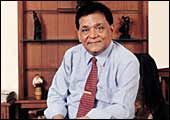 All
through the 1990s and early 2000s, when India Inc was busy getting
the most out of existing capacities rather than investing in new
ones, and when the government's emphasis on infrastructure had more
to do with words than action, L&T flourished. Now, given the
all-too-real (and imperative) focus on infrastructure and the coming
investment boom-Mumbai-based brokerage ICICI Securities estimates
the total investment between 2004 and 2006 at $51 billion, Rs 2,29,500
crore-the company should do even better. Engineering and construction
have always been the mainstay of L&T; now, following the June
2003 sale of its cement business to Grasim, they account for over
80 per cent of the company's revenues. The Engineering, Contracts,
and Construction division, popularly abbreviated as l&t ecc
is the engine driving this; it hopes to close this year with Rs
6,500 crore in revenues (L&T itself, hopes to do Rs 12,000 crore)
and boasts orders in hand of the magnitude of some Rs 10,000 crore.
"We make the things that make India proud," laughs A.
Ramakrishna, President and Joint Managing Director, L&T ECC,
repeating the company's advertising-line, a reference to the 40
fertiliser plants, 70 power plants, several car factories and airports,
the Lotus Temple in New Delhi, and a new sports stadium (completed
in a mere 260 days) in Chennai, all built by L&T ECC. Pride
is one thing, performance another, and although L&T's net profit
margin (in 2003-04) was a healthy 8-9 per cent, analysts believe
it could have been much higher if the company had focussed exclusively
on large projects. "In five years, we will have an overseas
subsidiary with full-fledged operations," adds A.M. Naik, Managing
Director, L&T, explaining that the company plans to parlay recent
opportunities in construction in Africa, Russia, West Asia and Malaysia
into a global presence. Until then, however, the company will have
its hands full dealing with the infrastructure-boom. All
through the 1990s and early 2000s, when India Inc was busy getting
the most out of existing capacities rather than investing in new
ones, and when the government's emphasis on infrastructure had more
to do with words than action, L&T flourished. Now, given the
all-too-real (and imperative) focus on infrastructure and the coming
investment boom-Mumbai-based brokerage ICICI Securities estimates
the total investment between 2004 and 2006 at $51 billion, Rs 2,29,500
crore-the company should do even better. Engineering and construction
have always been the mainstay of L&T; now, following the June
2003 sale of its cement business to Grasim, they account for over
80 per cent of the company's revenues. The Engineering, Contracts,
and Construction division, popularly abbreviated as l&t ecc
is the engine driving this; it hopes to close this year with Rs
6,500 crore in revenues (L&T itself, hopes to do Rs 12,000 crore)
and boasts orders in hand of the magnitude of some Rs 10,000 crore.
"We make the things that make India proud," laughs A.
Ramakrishna, President and Joint Managing Director, L&T ECC,
repeating the company's advertising-line, a reference to the 40
fertiliser plants, 70 power plants, several car factories and airports,
the Lotus Temple in New Delhi, and a new sports stadium (completed
in a mere 260 days) in Chennai, all built by L&T ECC. Pride
is one thing, performance another, and although L&T's net profit
margin (in 2003-04) was a healthy 8-9 per cent, analysts believe
it could have been much higher if the company had focussed exclusively
on large projects. "In five years, we will have an overseas
subsidiary with full-fledged operations," adds A.M. Naik, Managing
Director, L&T, explaining that the company plans to parlay recent
opportunities in construction in Africa, Russia, West Asia and Malaysia
into a global presence. Until then, however, the company will have
its hands full dealing with the infrastructure-boom.
-Nitya Varadarajan
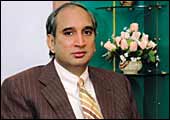 MATRIX
LABORATORIES MATRIX
LABORATORIES
Nimmagadda Prasad/Chairman and CEO
Reloaded. Revolutions To Come
"I need an
ID when I travel abroad," smiles Nimmagada Prasad, Chairman
and CEO, Matrix Laboratories. The 42-year-old six-footer is explaining
his recent acquisition of an international driver's licence; the
id is a pre-requisite for entry into technology parks in other parts
of the world, several of which Prasad visits regularly. He is unlikely
to face a similar problem in India: most people know him. As they
would a CEO who took a company with a negative net worth and transformed
it into one with a net worth of Rs 650 crore in four years. As one
would expect it to, D-street has reacted ecstatically to the turnaround:
the Matrix stock quotes at around Rs 1,800 today, up from just around
Rs 30 two years ago.
Matrix's success hinges on its ability to convince
the world at large-the universe includes hard-nosed private equity
investors from Newbridge India Investment Limited and Temasek-that
it can make a go of its API (Active Pharmaceutical Ingredients;
bulk drugs in layspeak) model. So, the company is into contract
manufacturing of formulations, contract research (of New Chemical
Entities) and the supply of bulk drugs, but it does not play directly
in the booming (and intensely competitive) generics (read: drugs
that have just gone off patent) market, choosing instead to work
as a facilitator and partner for generics companies. The result
is a promising revenue stream of APIs (such as Citalopram, which
once accounted for 50 per cent of the company's sales and now accounts
for 27 per cent), contract manufacturing opportunities, and ARVs
(anti-retroviral, used in the manufacture of aids drugs). Interestingly,
this helps balance net profit margins between a low of 15 per cent
for the ARVs to a high of 50 per cent for select APIs. "We
are now increasing our ability to deliver value by looking at contract
manufacturing of finished dosages," says C. Ramakrishna, former
CFO and now an advisor to the company. Analysts believe all this
warrants a valuation as high as Rs 2,542 crore. It well may.
-E. Kumar Sharma
PANTALOON RETAIL
Kishore Biyani/Managing Director
India's Wal-Mart
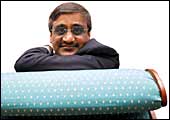 IIn
1987, Kishore Biyani was a small trouser manufacturer; today, he
is India's Mr. Retail. Others, notably Sanjiv Goenka of the RPG
Group, have staked claim to that title in the past, but with Biyani's
Pantaloon Retail planning to quadruple its retail reach, spanning
three formats and even more brands, Big Bazaar, Pantaloon, Food
Bazaar and Central from 1.3 million square feet to 5 million square
feet over the next two years, the man, more than anyone else, has
the opportunity to build India's Wal-Mart. "To continue opening
stores at the rate at which he is doing without being exhausted,
is something most players in this sector have not been able to manage,"
says Harminder Sahni, Principal Partner, ksa Technopak, a retail
consultancy. Sahni is right, scalability has been the Nemesis of
most Indian retailers, but Biyani has managed to consolidate operations
and grow them, all at once. "Making sure we stay ahead of competition
is my present job," laughs Biyani. Well, he is proving to be
adept at that. IIn
1987, Kishore Biyani was a small trouser manufacturer; today, he
is India's Mr. Retail. Others, notably Sanjiv Goenka of the RPG
Group, have staked claim to that title in the past, but with Biyani's
Pantaloon Retail planning to quadruple its retail reach, spanning
three formats and even more brands, Big Bazaar, Pantaloon, Food
Bazaar and Central from 1.3 million square feet to 5 million square
feet over the next two years, the man, more than anyone else, has
the opportunity to build India's Wal-Mart. "To continue opening
stores at the rate at which he is doing without being exhausted,
is something most players in this sector have not been able to manage,"
says Harminder Sahni, Principal Partner, ksa Technopak, a retail
consultancy. Sahni is right, scalability has been the Nemesis of
most Indian retailers, but Biyani has managed to consolidate operations
and grow them, all at once. "Making sure we stay ahead of competition
is my present job," laughs Biyani. Well, he is proving to be
adept at that.
-Priyanka Sangani
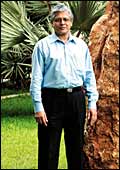 PRICOL PRICOL
Vijay Mohan/Vice Chairman and Managing Director
Instrument Of Success
Circa 2004, the
Indian auto-components sector is replete with fairy-tales. Some
have to do with the Deming Medal, the Oscar-equivalent for the quality-conscious.
Others have to do with superior financial performance. And still
others, with a foray into the international domain, not merely through
exports but through a foreign acquisition or greenfield venture.
Coimbatore-based Pricol has achieved a measure of success on all
three parameters, although not of the same magnitude as, say, a
Bharat Forge. If there's something going for the 30-year-old company
that boasts a 50 per cent-plus share of the automotive-instrumentation
and sensors (think speedometers, tachometers, fuel injection sensors)
market, it is its focus on a profitable niche of the auto-components
market (in part brought about by a rash Rs 50 crore investment in
an agri-products diversification that went nowhere and seems to
have taught Pricol a lesson) and the fact that it is fast approaching
a point of inflection. Pricol will close this year with revenues
of Rs 450 crore; exports will account for 13 per cent of its turnover;
and it is considering an overseas base or two (Pricol already exports
to Suzuki and Piaggio). These, combined with an outsourcing drive
and complemented by investments in R&D (to the tune of 3.5 per
cent of revenues each year for the past 10), should help the company
graduate into the next league. "We have been too vertically
integrated from the beginning," says Vijay Mohan, Vice Chairman
and Managing Director, Pricol. "We make all we require, from
tooling machines to components." The outsourcing drive, Mohan
reckons, will allow him to redeploy a chunk of the company's workforce
of 4,000 into "newer innovative product lines". That,
in turn, could result in a happy-ever-after story in 2005.
-Nitya Varadarajan
SOLECTRON CENTUM
Apparao Mallavarapu/Managing Director
Made In India
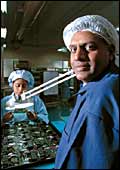 Hardware
is definitely in (see India's Rs 75,000 crore Hardware Opportunity,
Business Today, February 29, 2004). Ergo, companies such as Solectron
Centum must be in too. Like Flextronics (see Software Inside on
page 64), Solectron is an electronics manufacturing services (EMS)
company (a $12-billion, Rs 54,000-crore one) and Solectron Centum
is its Indian arm. EMS is the future of hardware and any booming
hardware market (India is on its way to becoming one, remember?)
is fair game for companies such as Solectron. One reason for that
is the unique characteristic of hardware markets around the world:
steep obsolescence curves, continual reduction in prices and large
volumes. The other is an increasing trend among hot product start-ups
(Apparao Mallavarapu, Managing Director, Solectron Centum, lists
Tejas Networks and Exalted) to "focus on their core strengths
of research and development and completely outsource manufacturing".
A few months ago, Solectron shut its Harlow plant in the UK and
moved the equipment to Bangalore. With revenues of Rs 35.72 crore
and a net profit of Rs 8.23 crore last year (Rs 20.68 crore and
Rs 7.47 crore in the first six months of this year), Solectron Centum
is yet to arrive. When the hardware boom intensifies, it surely
will. Hardware
is definitely in (see India's Rs 75,000 crore Hardware Opportunity,
Business Today, February 29, 2004). Ergo, companies such as Solectron
Centum must be in too. Like Flextronics (see Software Inside on
page 64), Solectron is an electronics manufacturing services (EMS)
company (a $12-billion, Rs 54,000-crore one) and Solectron Centum
is its Indian arm. EMS is the future of hardware and any booming
hardware market (India is on its way to becoming one, remember?)
is fair game for companies such as Solectron. One reason for that
is the unique characteristic of hardware markets around the world:
steep obsolescence curves, continual reduction in prices and large
volumes. The other is an increasing trend among hot product start-ups
(Apparao Mallavarapu, Managing Director, Solectron Centum, lists
Tejas Networks and Exalted) to "focus on their core strengths
of research and development and completely outsource manufacturing".
A few months ago, Solectron shut its Harlow plant in the UK and
moved the equipment to Bangalore. With revenues of Rs 35.72 crore
and a net profit of Rs 8.23 crore last year (Rs 20.68 crore and
Rs 7.47 crore in the first six months of this year), Solectron Centum
is yet to arrive. When the hardware boom intensifies, it surely
will.
-Venkatesha Babu
 SUZLON
ENERGY SUZLON
ENERGY
Tulsi Tanti/Chairman
Money From Thin Air
As a businessman
running a smallish textile company Tulsi Tanti, Chairman, Suzlon
Energy would often gripe about power- and capital-costs. In 1995,
after some serious research into alternative sources of energy,
he decided that wind-power was just the thing. Reason? It was one
form of energy whose production-costs would remain the same year
after year (thermal energy has an in-built escalation of around
5 per cent a year). The capital costs involved-the technology required
is far more sophisticated than the burn-and-sell logic of thermal
energy, for instance-are higher, but Tanti is certain that over
time, wind energy will cost far less than thermal energy. The 400
mw of energy Suzlon will produce this year, for companies such as
Bajaj Auto, Jindal Steel and Tata Power (it resells this to customers)
and entire industry clusters such as Tirupur, will cost almost the
same as thermal energy, but over the next five years, claims Tanti,
it will be 15 per cent less expensive. Suzlon's business model is
simple: companies buy wind energy turbines from it largely driven
by the desire to reap the benefits of depreciation (they are allowed
to depreciate their investments by 80 per cent in the first year);
Suzlon, manages the capacity and charges a maintenance plus operations
fee; over time, this fee will come down as the company becomes more
efficient at managing the operation; ergo, the cost of wind-energy
will reduce. This model has worked well enough for the company to
target Rs 2,000 crore in revenues this year (it did around Rs 900
crore last year) and attract investments from Citicorp International
and ChrysCapital. Competition in the business is pretty intense-there
are some five wind-energy companies operating in India-and there
are concerns in some quarters that Suzlon's wind-energy turbines
(a capacity of 350 KW and higher) are far too powerful given the
low wind density in India, but as long as the company can manage
its costs and tax laws allow the depreciation-benefit, the company
should sail smoothly on.
-Priya Srinivasan
TATA POWER
Firdose Vandrevala/Managing Director
Charge Of The Light Brigade
 It
is the difference between a prosperous farmer contentedly tilling
his fields and a hunter, going out, fighting and gathering food,"
says Firdose Vandrevala, Managing Director, Tata Power. The man
is referring to the transformation in the company, once best known
for the quality of power supply in Mumbai, its first foray into
retail distribution (today, the company also distributes power in
parts of Delhi). If 2003's Electricity Act was expected to jump-start
private investment in the power sector, then Tata Power's plans
are proof that this has indeed happened. Over the next five years,
the company will double its power generation capacity from the existing
2,200 mw. The transmission (Tata Power recently bagged a $32-million
or Rs 144-crore contract from the Power Grid Corporation of Bangladesh
to construct a 187-km power line) and distribution business serves
as an ideal buffer for the generation one, where tariffs have recently
dropped, a fact manifested in the company's lower revenues and net
profits for the first half of this year (Rs 2,027 crore as opposed
to Rs 2,143 crore last year and Rs 240 crore as compared to Rs 270
crore). And although regulation can play spoilsport anytime-for
instance, the Government could decide to reduce the assured return
on equity promised to private producers of power from the existing
16 per cent-analysts are sanguine about Tata Power's prospects.
"The company is conservative with its plans, does not rush
into projects and is very thorough in what it does," says Sameer
Ranade, an analyst at Mumbai brokerage Pioneer Intermediaries. And
it pays to be a long distance runner in the power sector. It
is the difference between a prosperous farmer contentedly tilling
his fields and a hunter, going out, fighting and gathering food,"
says Firdose Vandrevala, Managing Director, Tata Power. The man
is referring to the transformation in the company, once best known
for the quality of power supply in Mumbai, its first foray into
retail distribution (today, the company also distributes power in
parts of Delhi). If 2003's Electricity Act was expected to jump-start
private investment in the power sector, then Tata Power's plans
are proof that this has indeed happened. Over the next five years,
the company will double its power generation capacity from the existing
2,200 mw. The transmission (Tata Power recently bagged a $32-million
or Rs 144-crore contract from the Power Grid Corporation of Bangladesh
to construct a 187-km power line) and distribution business serves
as an ideal buffer for the generation one, where tariffs have recently
dropped, a fact manifested in the company's lower revenues and net
profits for the first half of this year (Rs 2,027 crore as opposed
to Rs 2,143 crore last year and Rs 240 crore as compared to Rs 270
crore). And although regulation can play spoilsport anytime-for
instance, the Government could decide to reduce the assured return
on equity promised to private producers of power from the existing
16 per cent-analysts are sanguine about Tata Power's prospects.
"The company is conservative with its plans, does not rush
into projects and is very thorough in what it does," says Sameer
Ranade, an analyst at Mumbai brokerage Pioneer Intermediaries. And
it pays to be a long distance runner in the power sector.
-Abir Pal
 TATA
CONSULTANCY SERVICES TATA
CONSULTANCY SERVICES
S. Ramadorai/CEO & MD
#1
TCS was an obvious
choice for the 2003 and 2004 listings. If it didn't feature in either,
it was because it was yet to become a company. Today, however, TCS
isn't just any company; it is the second most valuable Indian private
sector company (BT 500, see Business Today, November 7, 2004), the
largest software company in the country, and the first among equals
in what Sandeep Shenoy, a strategist at Mumbai brokerage Pioneer
Intermediaries, terms "the golden trio of the industry",
TCS, Wipro and Infosys.
There's a lot going for the company that employs
36,000 (from 30 nationalities if you must know), boasts 151 sales
offices spanning 32 countries, and 31 delivery centres, spanning
10. Attrition, for the year ended 2003-04 was low, at 7.9 per cent,
on par with industry gold standard Infosys'; around 12 per cent
of the company's revenues came from the domestic market, serving
as a buffer against the vagaries of the global marketplace; its
recent acquisition of Phoenix Global gives it a toehold in the booming
business process outsourcing (BPO) market; and it has just come
off a successful, very successful IPO (The Rs 5,420-crore issue
was subscribed 7.7 times over). "We are strengthening our global
presence not just in it services but in infrastructure, it-enabled
engineering, consulting and packaged software," says S. Ramadorai,
CEO and Managing Director, TCS.
Nothing much can really go wrong for a company
operating with revenues of around $2 billion dollars (Rs 9,000 crore),
which is what TCS hopes to close 2004-05 with in a market growing
by over 30 per cent. Still, TCS must prove that its management processes
and people policies are at least on par with its two closest peers.
This, its first year in the public eye, is the time of reckoning.
-Abir Pal
VSNL
N. Srinath/Director (Operations)
A Giant Leap
 VSNL
literally bought its way into this listing, and only just. If the
company had not acquired Tyco Global Network on November 1, 2004,
for $130 million (Rs 585 crore), it is likely that it wouldn't have
figured in the 20 Companies to Watch in 2005. Ever since the Tata
Group acquired VSNL in February 2002, the company, and the group
have consistently made the headlines on the strength of strategic-
and operational-inertia. First, there was the fact that VSNL just
sat on the domestic long-distance telephony licence it had acquired
gratis, compensation of sorts for the premature end of its monopoly
on international long distance telephony. Then, the Tata Group took
its time rolling out its CDMA-based mobile service across the eight
circles for which it had licences (even today, it boasts a mere
6.57 lakh subscribers, well behind Reliance Infocomm, which boasts
83.87 lakh). As a result of its inability to originate and terminate
traffic, the company lost out on a portion of tariffs that would
have otherwise been its. The Tyco deal should change all that. In
one swoop, the company has acquired 60,000 kilometres of undersea
cable, connecting around 25 of the world's biggest cities (including
several in the us). The acquisition also comes at a time when VSNL
is finally becoming aggressive, selling its offerings to corporate
customers; several it and IT-enabled services companies, for instance,
need bandwidth to pipe data to the US and the Tyco submarine cable
will help VSNL do just that. Better still, the company's 25,000-km
long domestic long distance network is in the process of being lit.
The last-mile is still a point of concern but even Tata Indicom,
the group's CDMA service, has been far more proactive this year
than it was in the past. "Our aim will be to leverage the telecom,
it and vertical domain strengths within the Tata Group to offer
managed telecom services to customers," says N. Srinath, Director
(Operations), VSNL. This is definitely a company whose time has
(ah! finally) come. VSNL
literally bought its way into this listing, and only just. If the
company had not acquired Tyco Global Network on November 1, 2004,
for $130 million (Rs 585 crore), it is likely that it wouldn't have
figured in the 20 Companies to Watch in 2005. Ever since the Tata
Group acquired VSNL in February 2002, the company, and the group
have consistently made the headlines on the strength of strategic-
and operational-inertia. First, there was the fact that VSNL just
sat on the domestic long-distance telephony licence it had acquired
gratis, compensation of sorts for the premature end of its monopoly
on international long distance telephony. Then, the Tata Group took
its time rolling out its CDMA-based mobile service across the eight
circles for which it had licences (even today, it boasts a mere
6.57 lakh subscribers, well behind Reliance Infocomm, which boasts
83.87 lakh). As a result of its inability to originate and terminate
traffic, the company lost out on a portion of tariffs that would
have otherwise been its. The Tyco deal should change all that. In
one swoop, the company has acquired 60,000 kilometres of undersea
cable, connecting around 25 of the world's biggest cities (including
several in the us). The acquisition also comes at a time when VSNL
is finally becoming aggressive, selling its offerings to corporate
customers; several it and IT-enabled services companies, for instance,
need bandwidth to pipe data to the US and the Tyco submarine cable
will help VSNL do just that. Better still, the company's 25,000-km
long domestic long distance network is in the process of being lit.
The last-mile is still a point of concern but even Tata Indicom,
the group's CDMA service, has been far more proactive this year
than it was in the past. "Our aim will be to leverage the telecom,
it and vertical domain strengths within the Tata Group to offer
managed telecom services to customers," says N. Srinath, Director
(Operations), VSNL. This is definitely a company whose time has
(ah! finally) come.
-Roshni Jayakar
|
